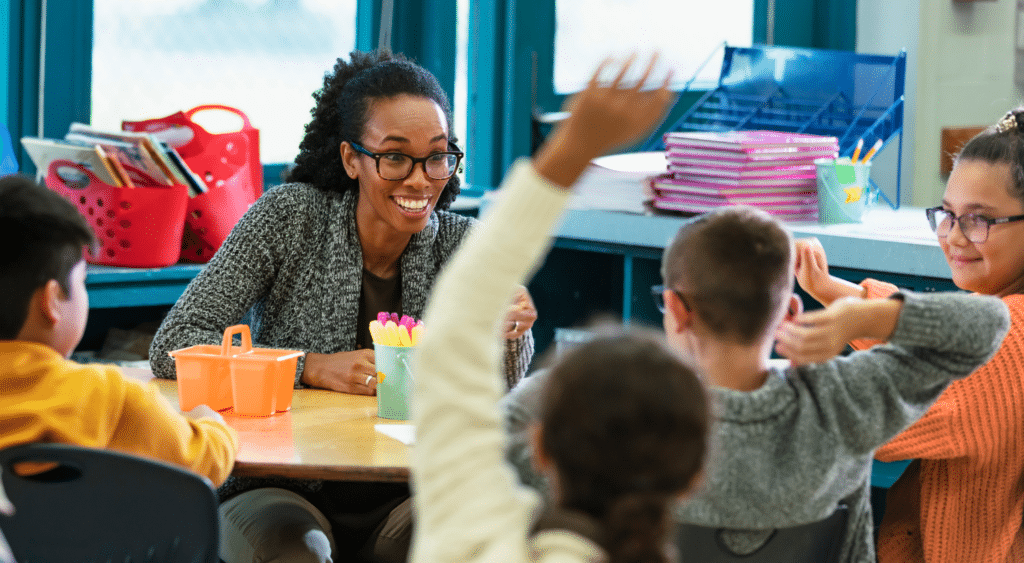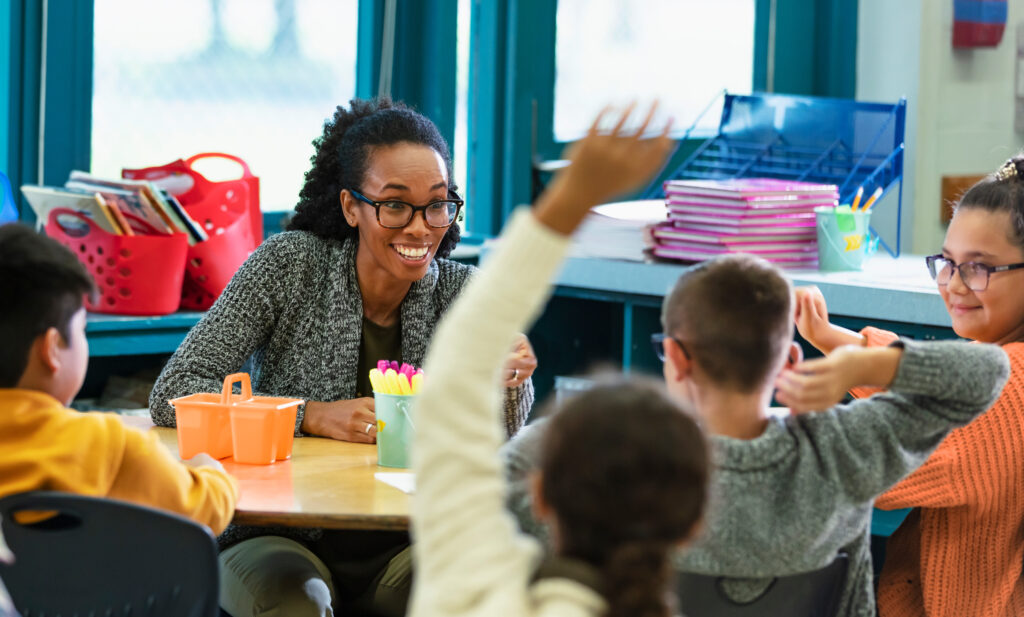Top lesson plans for substitute teachers in elementary school.

Being prepared for nearly anything is an important attribute for substitute teachers. When teachers aren’t able to leave detailed lesson plans for substitute teachers, you’ll want to keep students engaged.
Whether serving in a short- or long-term role, having a few backup lesson plans in your pocket is key. Need a few ideas? We’ve compiled a list of subject-specific activities or sub plans for elementary school students. If unsure if these activities will work, ask an administrator or a neighboring teacher. They might also have other ideas related to the curriculum.
Top kindergarten through third grade lesson plans.
Language arts: ABC object match.
Practicing the alphabet can be hands-on with the ABC object match activity. Give the students a letter and have them find an object in the classroom whose name starts with the letter you gave them. Encourage students in higher grades to find objects that are not as obvious as a desk, drawer, or door.
Math: shape hopscotch.
Shape hopscotch is a creative way for students to release their energy and have fun learning math. First, cut out several oversized, colorful shapes out of construction paper and laminate them if you plan to reuse them. Then, give each shape a different color and tape them to the floor in random order. Ask the children to hop, jump, dance, or crawl through the shape path, naming the shapes as they go. For students in higher grades, add addition and subtraction problems on each shape to solve before jumping to the next shape.
Science: birthday season.
Birthday Season is a quick and easy lesson plan to teach lower elementary students about the four seasons. Hang pictures of summer, fall, winter, and spring weather. Give each student a tag with their name on it. Have them stick the tag on the season that matches their birthday. To make this activity more challenging, teach students about other events during the four seasons, like hibernation, monsoons, or migration.
Reading: pick a book.
Teaching reading to elementary students involves picking a book appropriate for their age level. You can point to sight words in a book for early readers and have them take turns reading or guided writing for students in grades two or three. Allowing the students to choose which books to read teaches them decision-making skills in a group.
Art: greeting cards.
Creating a greeting card is a hands-on approach to teaching multiple subjects in one activity, including shapes, art, and writing. Allow students to draw, color, or paint the cover art for their greeting card. Teach students how to write messages inside the card and adapt them to reflect holidays or events happening at the time.
Social studies: recycle it.
This activity begins with teaching students about recycling, reusing, and reducing various items to benefit the planet. Fill a large garbage bag with multiple items, including glass, paper, plastic, and aluminum. Have each student pick an item in the bag and discuss which category it should be in as a group. You can adapt this activity for various age groups by using items to recycle that are easier or harder to sort.
Health: nutrition.
Nutrition is an important topic at every grade level, and substitute teaching lesson plans can be incorporated into classroom snack times. Teach students about different food groups and offer hands-on, delicious, healthy activities. For students in grades two and three, analyze the labels of their favorite foods. In kindergarten and first grade, host a taste test.
History: election day.
Election Day activities are perfect for history class. You can teach students about former and current leaders elected into office at all grade levels. You can also ask students to create an interview question they want to know from the President. Students in second and third grades can even mail a letter or card to the President.
Music: making music.
Fill a basket with various small instruments, ensuring enough for each student. Children will choose an instrument and sit anywhere they want in the room as long as they can see you. Hold up a picture of each instrument, so children with the instrument play them until you lower or hide the picture. You can show multiple pictures at once or one at a time.
STEM: wash your hands.
Teaching students how to properly wash their hands to eliminate all germs is essential. For this activity, break the students into small groups so each can compete in the washing activity at different times unless you can access multiple sinks or wash stations. Instruct the washing group to paint their hands with non-toxic washable paint, front and back, letting the paint dry for a few minutes. Ask students to wash their hands with water only for 20 seconds. Observe how much paint is left. Wash again using soap for 20 seconds. Observe how much remains. Finally, ask students to wash until all or most of the paint is gone. Once all groups have completed the activity, discuss the experience with the class.
Top fourth grade through fifth grade lesson plans.
Language arts: spelling race.
Students can be competitive in upper elementary, and having a spelling race is a way to show them that competition and practice can be fun. Use the whiteboard or chalkboard and ask two students to go to the board simultaneously. Say a word from their weekly spelling list, then say “go” or ring a bell to start the race. The student who writes the word correctly first wins. You can also divide the class into teams. Winning teams can earn an extra minute at recess, a sticker, or something small they enjoy.
Science: insect inventor.
Insect Inventor is a fun substitute lesson plan that allows students to use their imagination and research skills. When teaching students about various insects, tell them you need them to develop a new one. Provide them with pictures and information on numerous insects alive today or extinct. They can choose different features of insects to add to their unique creation.
Art: art with objects.
This activity allows students to paint with unusual objects. Teach students to use other objects instead of a paintbrush, such as feathers, q-tips, leaves, or fingers. Let them choose from various objects to paint with and be creative.
Social studies: portrait of a classmate.
Understanding diversity and recognizing other cultures is essential to students, starting with their classmates. Portrait of a Classmate helps students get to know each other better. Have them partner with one or more students in their class and conduct interviews using your sample questions.
Health: scenario stations.
Scenario stations help students reflect on decisions that are physically and mentally healthy. Set up and label three or four stations, ask students to form groups of three or four, and visit the stations. At each station, they will find a paper containing a written scenario involving a fictional student their age making appropriate and inappropriate decisions. The students will be given a list of questions to answer and discuss whether the fictional student’s decisions are healthy or unhealthy.
English: writing prompts.
Let students practice their writing skills using their imaginations. Write numerous writing prompts on slips of paper, then place them in a box. Have each student draw one slip and use the writing prompt provided to create a mini-story. Students who want to read their stories to the class can do so.
Vocabulary: word scramble.
Word Scramble is fun and can be played individually with worksheets, in small groups, or as a class. In larger groups, you can write random letters on the smart board or chalkboard, and the first group to develop a word gets a point. The ones with the most points at the end of the game can win a small, educational prize.
Music: competition judge.
Before this activity, use the computer and search for singing competition auditions on popular television shows like The Voice or American Idol. In class, play one audition at a time and ask the students to analyze and judge it. Provide the students with age-appropriate judging rubrics that you discuss with them before the activity. After each audition, allow the class to express their opinions on why they voted the way they did.
Geography: unique food.
Using a spinning globe, ask students to spin and stop the globe on a random country. Before the activity, print pictures or find videos of the unique foods people in different countries consume. When a student chooses a place on the globe, use your resources to teach students about the foods from that country. When possible, offer samples to taste if they choose.
Math: spending money.
Fourth and fifth graders can learn various aspects of spending money, including needs versus wants, payment methods, and how marketing influences them to make purchases. Have students create a poster separating their needs versus wants and share their explanations with the class. Show age-appropriate advertising videos and discuss how marketing tactics get buyers to purchase items. Also, discuss how peer pressure also influences spending money.
Final Thoughts.
As an educator, it’s important to remember that students have different learning styles. When substitute teaching short-term, you may not know students’ individual needs, but you should strive to craft lesson plans that are enriching for everyone.
Remember that these ideas are backup lesson plans for substitute teachers. Following the teacher’s plans must remain a priority since the school district develops the core curriculum and the instruction guidelines. The district uses these to set student goals and evaluate academic progress.
For lesson plans for substitute teachers in middle and high school, check out this article.
Looking for flexible work that matters? Visit myKelly to learn more about becoming a substitute teacher or fill out this interest form to have a recruiter share more opportunities with our partner districts..

View Related: Article New positions
You might like
Become a Highly Requested Substitute Teacher
3 minute read
An Inside Look at Kelly Education’s Hiring Process
6 minute read
Become a Highly Requested Substitute Teacher
3 minute read
An Inside Look at Kelly Education’s Hiring Process
6 minute read
Find your next job
Discover thousands of temporary, full-time, and remote jobs for beginning and experienced job seekers.


